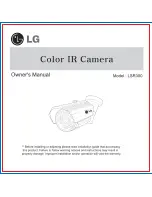
Bonito Technical Manual
V2.4.0
79
Appendix
2: Permanent exposure mode. Used to maximize
the exposure time. If activated, the
exposure time equals the frame duration.
Consequently any exposure time setting,
controlled by E=<p32> or by external
signal, is ignored.
3: Reserved.
N=<p16> : This parameter sets the number of lines per frame. The
actual line count is N+1, the default of N=6BD results
into 1726 lines. If the double ROI mode is active (D=1)
the actual line count is (N+1)*2. Please consider this in
minimum frame duration calculations for the image on demand
(IOD) mode (see M=<p8>). See also parameters A=<p16>,
B=<p16>, D=<p8> and I=<p8> for more information regarding
sensor line addressing. Valid range 0...6BF (1 to 1728
lines).
S=<p8> : Sensor mode control.
<****_*ccc>
\_|
+-c: Channel mode configuration.
0: Single channel mode (half pixel clock
speed). Full line length of 2320 pixels is
output at the Camera Link connectors O2/O1
(or CL1/CL2). The data is mirrored at
O4/O3 (not available in all variants), but
note that the CC signals and SerTC/SerTFG
are handled separately. e.g. the
trigger source selection (T=<p8>) and
serial port configuration (s=<p8>) might
need adjustments if only the connectors
O4/O3 are connected to a frame grabber.
1: Dual channel mode (full pixel clock
speed). The image is split vertically into
a left and a right half. each half
has a horizontal size of 1160 pixels and
is output separately on its own Camera
Link 10-tap channel. The left half travels
via the left Camera Link channel at the
connectors O2/O1 (or CL1/CL2) and the
right half travels via O4/O3 (not
available in all variants) respectively.
3: Dual channel compatibility mode (full
pixel clock speed). This mode basically is
the same as S=1. For frame grabber
compatibility reasons 40 pixel columns at
the left and right side (of the full
image) are dropped so that the line length
of each half image is divisible by 16.
The effective line length in this mode is
2 x 1120 = 2240 pixels.
5: Same as mode 1, but with right image half
via O2/O1 (or CL1/CL2) and left image half
via O4/O3 (if available).
7: Same as mode 3, but with right image half
via O2/O1 (or CL1/CL2) and left image half
via O4/O3 (if available).





































